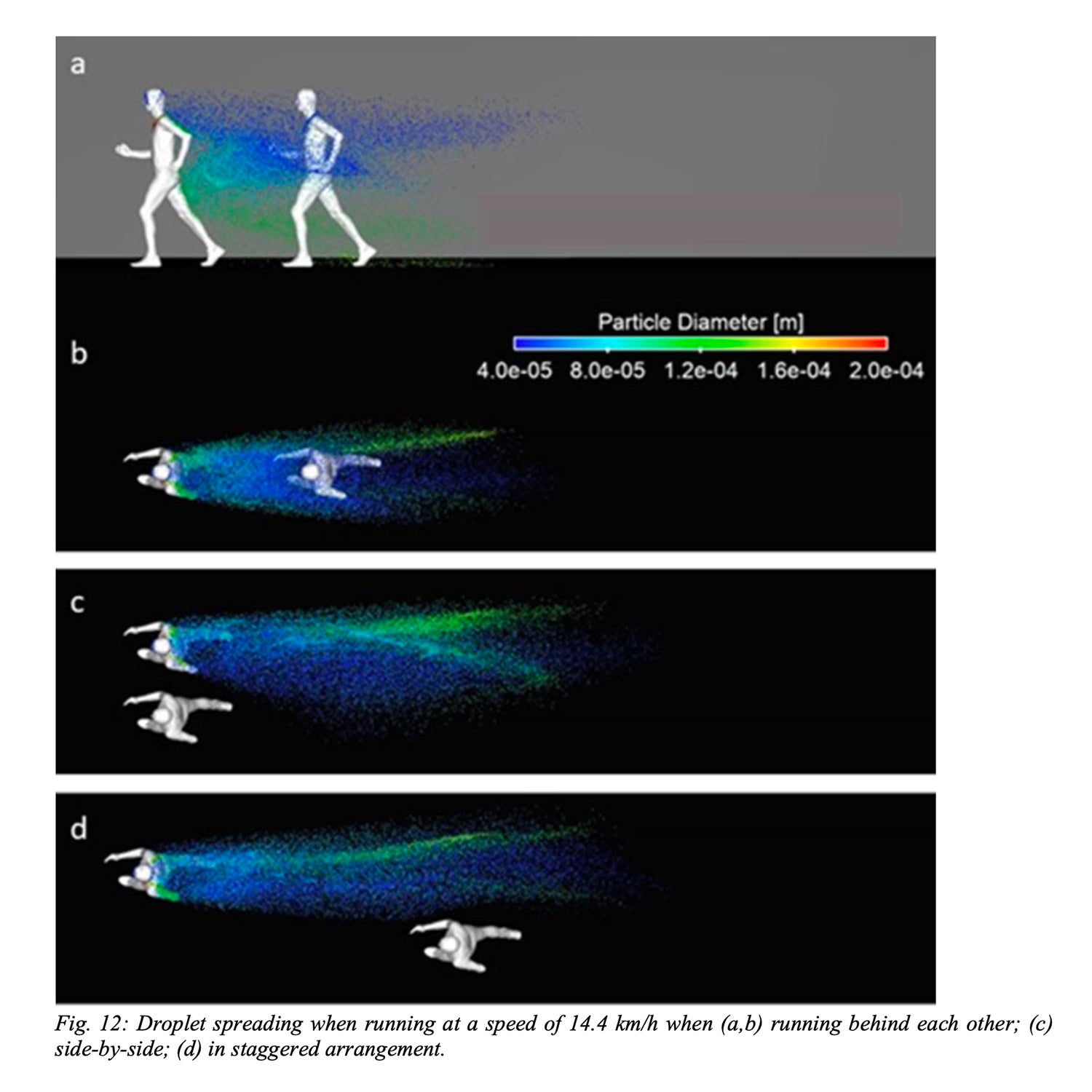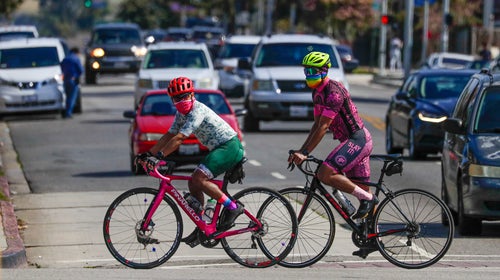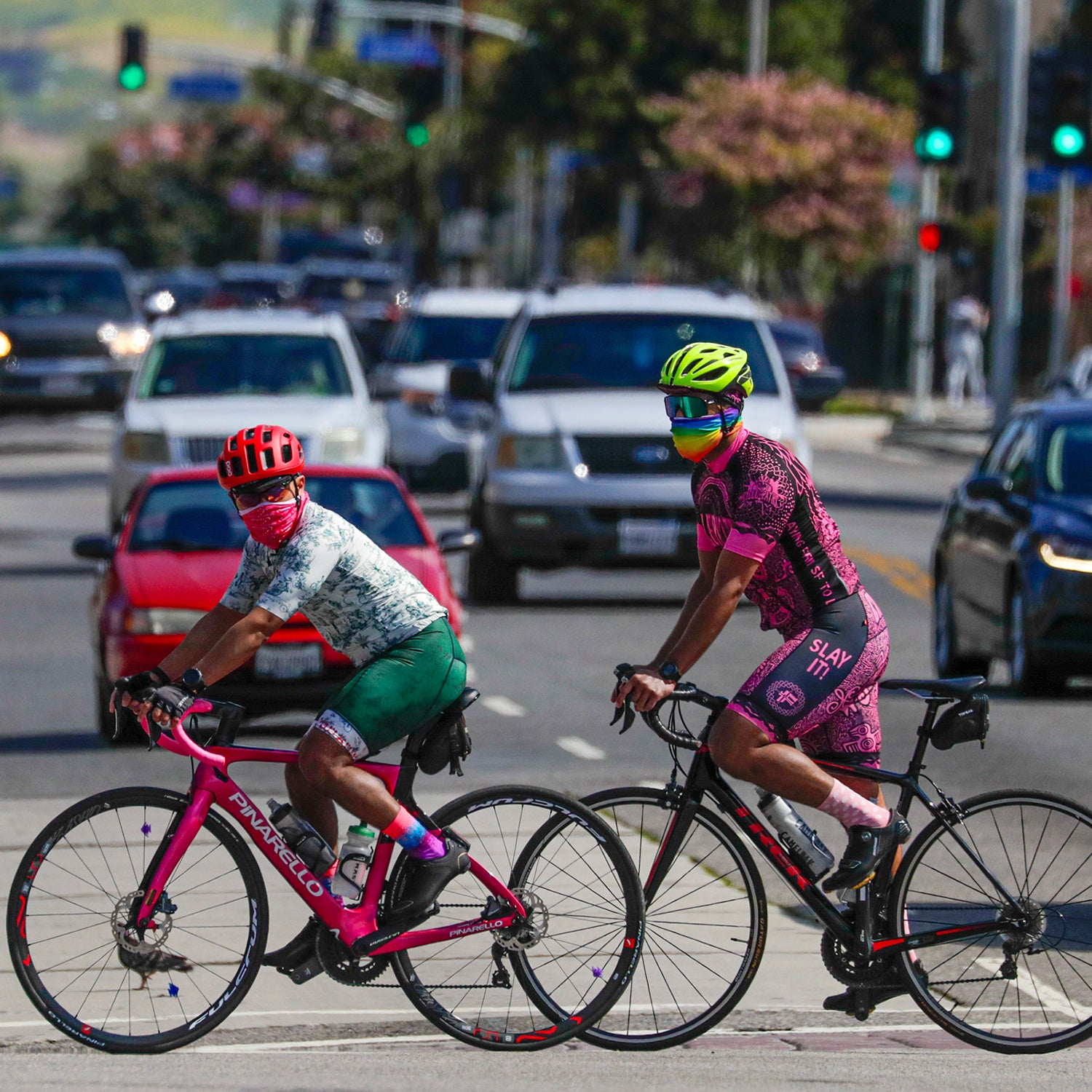Last Saturday morning dawned bright and warm, perfect conditions for a ride before a looming spring storm on Coloradoâs Front Range. When weather permits, early morning is my favorite time to ride anyway. But in our current social-distancing era, it also seems like the safest option. Our trails have seen exceptional traffic as people seek the solace of exercise and open space.
But even at that hour, I was not alone. On the bike path, I passed dog walkers and runners. I pulled up my Buff and gave as much space as possible. On the trail, every time I spotted another person, I started planning our encounter: Where would IÌıstep off the singletrack? How far could I move away? And was it far enough?
My anxiety was heightened byÌıonline conservations around a research project released just a fewÌıdays earlierÌıthat used computational fluid dynamics (CFD) software to suggest that the widely accepted six-foot distance wasnât nearly enough for runners and cyclists. Instead, the authors said, walkers should stay at least 13 feet away, fast runners around 30 feet, and cyclists up to 65 feet depending on their speed. The white paperâand its accompanying data visualization of an ominous cloud of coronavirus hitting an unwitting runnerâwas an instant hit with the press and social media, thanks largely to a that went, um, viral. Even four-time Tour de France winner Chris FroomeÌı to his 1.5 million followers.
Which was a problem, because the author of the Medium post, Jurgen Thoelen, never spoke to Bert Blocken, the civil engineer who led the research, before the piece was published. (Blocken says he had no issues with the post, however.) Thoelen told ºÚÁϳԹÏÍø he merely aggregated two stories from the Belgian press. Those Belgian journalists did interview BlockenÌıbut were working off a basic summary of the research andÌınotÌıâbecause it hadnât been finished yet, much less submitted to an academic journal. Crucially, the research project was an aerodynamics study that used CFD simulations to model how a runnerâsÌıexhalations might spread behind them, and it only glancingly addressed virology.ÌıThe researchers hoped to provide useful information for athletes for safer social distancing while riding and running, a goal that they felt warranted an earlierÌırelease than the typical academic publishing cycle would allow.
There was a fierce backlash, asÌı and initial media stories criticized everything from the paperâs conclusions to the CFD visualization to Blockenâs choice to forego all but the most cursory epidemiological framing for his findings (for example, the relative risk of infection). âThe Viral âStudyâ About Runners Spreading Coronavirus Is Not Actually a Study,â readÌı. âBe Careful Sharing This Viral SimulationâItâs Not an Actual Scientific Study,â readÌı.Ìı(It was a study, actually; Blocken just hadnât finished writing the full paper yetâthough the initial wave of criticsÌımay notÌıhave known this.)
All of that unfolded in about 72 hours, leaving many cyclists and runners feeling like theyâd been put into a windstorm of competing claims. What to believe? Was six feet enough distance? Was it safe to ride or run outside at all? Or was the whole thing just a bunch of bullshit, the latest example of COVID hucksterism masquerading as science?
Controversy aside, thereâs a quiet truth at the heart of Blockenâs study. âThe six-foot guideline is for people who are not moving,â says Linsey Marr,Ìıa professor of civil and environmental engineering at Virginia Tech who studies airborne transmission of infectious diseases. (Her comments, via email, were shared with multiple media outlets, not ºÚÁϳԹÏÍø exclusively.) MarrÌısays she found the study usefulÌıand in fact . âCommon sense, and this study, suggest that if someone is walking or running, we need to allow for more space,â she says.Ìı
According to health officials, there are three possible ways to contract respiratory diseases like COVID-19: touching a contaminated surface and then a mucous membrane liningÌıyour nose, eyes, or mouth; via infected droplets that land on those areas; or inhaling very small, aerosolized particles of the virus. Not all viruses spread via every mode, but the novel coronavirusÌımay. Blockenâs study focused on droplet spread.
If youâve ever been in a pack of cyclists or runners, youâve smelled someoneâs bad breathÌıor been hit with the spray from a particularly ill-aimed farmerâs blow. Those are aerosols and droplets. Every time you exhale, speak, cough, or sneeze, you expel a cloud of these fine liquid particles. Normally, exhaling produces the least amount of them, but during exercise, volumes more than double because our breathing is deeper and more rapid. According to in the Journal of the American Medical Association by Lydia Bourouiba, an MIT professor who studies infectious-disease transmission and fluid dynamics, these cloudsÌıcan travel up to 27Ìıfeet after a sneeze.

The particles we exhale are largely invisible to the naked eye. All can carry the virus. Studies on the amount of particles per breath vary in their conclusions; it may be as little as a few hundred per breath, or thousands. The smallest particles, under about tenÌımicrons in size, are considered aerosolsÌıand can float for hours or even days in an undisturbed environment. The larger ones (which can be up toÌıhalf a millimeter in diameter) are classified as dropletsÌıand either fall to the ground or evaporate into .
If you pass through a cloud of infected droplets and aerosols before the droplets fall to the ground or the aerosols disperse, youâre potentially exposed to the virus, says Dylan Morris, a doctoral student in ecology and evolutionary biology at Princeton who studies virus ecology. âCumulative risk is the appropriate way to think,â he wrote in an email to ºÚÁϳԹÏÍø. In other words, the longer or more often youâre exposed, the greater your risk. This is why group rides are verboten right now; youâre literally traveling in a slipstream of other peopleâs breath for miles at a time. But, adds Morris, virus infection in most cases is thought to be a âsingle hit,â where any single virion that invades a host cell could potentially cause an infection. So could a solo rider passing a COVID-19 carrier get sick from a single breath? Theoretically, yes: âAny single encounter with contaminated air may have a low probability of getting you sick,â says Morris. Is this a realistic outcome? Thatâs far more complex.Ìı
Most academic research on respiratory-disease transmission via droplets and aerosols focuses on indoor environments. That makes sense, becauseÌıamong the most pressing problems in infectious disease is how to limit spread in densely populated settings. But, Morris pointed out, that meansÌıthat outdoor transmission is something of a cipher right now. That gap in knowledge is what Blocken was trying to address.
Jurgen Thoelen, who authored the Medium post that blew up, is an entrepreneur and a tech executive, but doesnât have a science or journalism background.ÌıÌı
Blocken, on the other hand, isÌıa highly regarded expert whoâs published almost 200 peer-reviewed studies. A professor of civil engineering at both Katholieke Universiteit Leuven in Belgium and Eindhoven University of Technology in the Netherlands, he has two equally eclectic specialties: air-flow modeling in the built environment, and sports aerodynamics. On the latter front, heâs a regular consultant with the WorldTour cycling teams Jumbo-Visma and Groupama-FDJ, and he alsoÌı on Eliud Kipchogeâs second, successfulÌıattempt to run a sub-two-hour marathon. A cyclist himself, Blockenâs own experiences and those of his friends spurred him to investigate safe social distancing during exercise.Ìı
He says he didnât intend to spark such a heated conversation. As Blocken tells it, a local media outlet canvassed Eindhoven faculty on what coronavirus-related research they were pursuing, and he sent a short summary of his work. The resulting story grabbed theÌıinterest ofÌınational outlets, which is where Thoelen picked it up.Ìı
And thatâs where Blocken probablyÌıwent wrong. Deluged with press requests, he willingly obliged. But that meant he delayed finishing and posting the full paper until around three days after the Medium post went supernova. So story after story, especially among news aggregators,ÌıwasÌıbased primarily on a brief research summary Blocken posted on his website. ThatÌısummary was essentially a series of informal notes describing the research in general terms, and it lacked both an explanation of the study methodology or any virological references (some of which were included in the full paper). The data visualization in particular,Ìıfeatured in the Medium post,Ìıproved an irresistible hook: a vivid, visceral depiction that didnât need explanation, with a trailingÌırunner coated in viral particles emitted by a runner in front.
That initial vacuum of hard data is partly why the critics pounced. A microbiologist quoted by Bicycling said the study had âzeroâ new information worth considering, while a story by Vice quoted a clearly irritated William Hanage, a prominent Harvard epidemiologist, as saying Blockenâs work was ânot really usefulâ and adding that he was concerned by how much attention the research had received.
While a âsingle hitâ may be enough to seed an infection, Princetonâs Morris also pointed out that the degree ofÌıexposure mattersâsomething Blocken didnât attempt to address. âMany of the virions that are inhaled will be caught by the airway or other physical barriers within our bodies before they can make it to a cell,â says Morris. âIn practice,Ìıyou need to be in the presence of a high concentration of virions to be at high risk.â And the risk of encountering these high concentrationsÌıoutside isÌıunknown.
In other words, Blocken wasnât trying to examine the relative risk of getting sick from droplets picked up from passing cyclists or runners butÌıonly whether you would encounter them well past the recommended six-foot distance.
In our interview, Blocken steadfastly denied that heâd made an error by not looking at the issue from a virology perspective as well as an aerodynamics one. âNo, no, no, that would have made the study less credible, because the information I needed from virology to have stronger conclusions in that regard are things that virologists are fundamentally disagreeing about right now,â he said. In other words, Blocken wasnât trying to examine the relative risk of getting sick from droplets picked up from passing cyclists or runners butÌıonly whether you would encounter them well past the recommended six-foot distance.ÌıBut Blockenâs research summary and full paper never explicitly call this out, and itâs reasonable that readers, especially those who saw stories that came out before the full paper did, might be alarmed by its findings.
He also saysÌıthat the data visualization wasnât intended to beÌıa literal depiction of a cloud. In the visualization, Blocken says there are fewer particles than would actually be emitted by a runner (as noted above, specific estimates of how many particles we emit actually vary widely), but their size is amplified to make them visible, which makes the cloud look denser.
And without any expert virological perspective on transmission risk, even readers of the full study are left with little to go on to judge danger. Finally, the highly specific recommendationsâ13Ìıfeet of space between walkersÌıand more than 60 feet for fast cyclingâseemed not only arbitraryÌıbut impractical. Blocken says the distances represent how far behind youâdÌıneed to be to preventÌıdroplets fromÌılanding on your face,Ìıalthough that wasnât explicitly stated in the research summary.
Blocken ruefully acknowledges that he should have been prepared for people to misinterpret his study. But the haphazard way it rolled out contributed to confusion, while the sparse initial data seemed to reinforce peopleâs preconceived notions, whichever way they leaned. The study was taken as either proof thatÌı, or it wasÌı that no change in distancing practice was needed.
The truth is likely somewhere in the middle.
Blockenâs work shows that exhaled clouds behave differently when the subject is in motion. In his simulation, the particles trail out in a tight, elongated teardrop in the athleteâs wake. A cyclist riding at 18 miles per hour (roughly the speed Blocken was modeling)Ìıtravels more than 25 feet per second, so even at that distance behind a leading rider, heâll pass right through the cloud well before the droplets settle out and aerosols disperse.
Whatâs more, while Blockenâs work focused mostly on droplet transmission, thereâs a vigorous debate right now about whether the novel coronavirusÌıcan be transmitted as an aerosol. AÌı on the original SARS outbreakâthe closest viral cousin to todayâs pathogenâfound that one particularly hard-hit apartment building in Hong Kong showed strong signs of spread among residents through aerosols that traveled through the buildingâs air shaft. A new research paper out of ChinaÌı 13Ìıfeet away from patients (this is less surprising when you consider the testing environment, a packed ICU ward in a Wuhan hospital). And aÌınew study that Princetonâs Dylan Morris coauthored found that half the virus emitted into a controlled environment (via a spray-nozzle apparatus) was still in the air an hour later.
At any rate, much of the conversation about droplets versusÌıaerosols may be hairsplitting. As aÌıpaper by MITâs BourouibaÌıand others points out, the size cutoffs for aerosols versus droplets (which is fiveÌıto tenÌımicrons forÌıtheÌıWorld Health Organization) are largely arbitrary. Droplet size and behavior is a continuum, not a binary divide. EvenÌı on airborne particles notes that droplets as large as 100 microns can remain in undisturbed air for almost six seconds.Ìı
All of that suggests that Blockenâs study has real relevance. âIâm not an expert in CFD, but the results look reasonable. Their approach and software is consistent with other studies I have seen,â says Virginia Techâs Marr, adding that her only caveat is that the running speed the study used, which equates to a 6:40 mile, is fairly fast. (A slower pace would necessitate lessÌısocial distance.)ÌıIngmar Jungnickel, who heads aerodynamic research at Specialized Bicycles, said that Blockenâs work portrays the complex flow patterns around cyclists that they see in their own wind-tunnel research. âItâs a very good representation of what you would find riding outdoors,â he wrote in an email reply. âThese simulations accurately predict (airflow) behavior in the real world.â Itâs worth noting that Blocken made a conscious decision not to try to account for natural outdoor airflow patterns like breezes or crosswinds (CFD models have weaknesses in capturing complex flow).
The study only considered droplets from 40 to 200 microns, which Blocken says appear to be the most dangerous (he added that he was going off other research, since this is not his area of expertise). But thatâs far from settled science. âDroplets much smaller than 40 microns, down to one micron in size or less, are thought to play a role in airborne transmission,â notes Marr. Several studies have also noted that smaller respiratory-disease particles tend to lodge deeper in the respiratory tractÌıand are associated with more severe infections.
In short, the study is a good first step, but thereâs still much thatâs unknown. âIâm the last person to say that this study is complete,â Blocken says. His work describes conditions that are necessary for infectionÌıbut not sufficient. Thereâs a chain of events that has to happen to close that circle:Ìıwhile exercising outside, you need to overtake another athlete who is a (likely pre- or asymptomatic) carrier, stay in that personâs slipstream long enough to encounter a non-dispersed cloud of particles, and ingest or inhale enough virions to give the virus a good chance of starting an infection.Ìı
Blocken says it was never his intent to discourage people from exercising outdoors, and experts we spoke to agreed that thereâs no need to stop people from running or riding.
âIn general, the risk of transmission outdoors is much lower unless youâre in a crowded location,â says Marr. âIâm an avid athlete who needs my daily workout, and for me personally, the benefits of exercise outweigh the risks.âÌı
But you should also change your outdoor-exercise etiquette. First, while wearing a mask the whole time youâre runningÌıprobably isnât necessary, using some kind of face covering when passing others isnât a bad idea, even if itâs just a neck tube. Lowering it when no one else is around could helpÌıto prevent it and your face from becoming wet (which could increase the risk of infection), though constantly touching your mask and face also carries exposure risks.
Most important, give more space. The specific distancing recommendations from Blocken may be impractical at times. But itâs also clear that itâs prudent to give more than six feet, according to Morris. âIâm a runner, and I wouldnât feel guilty or terrified if I occasionally passed within four meters (about 13 feet) of someone else,â he says, âbut equally, I would try not to make a habit of it.â (He also wears a mask.) Marr aims for at least tenÌıfeetÌıbut doesnât think thereâs a need for a mask. A good rule of thumb? Give as much space when passing others as is safely possible, whatever that is. If things are so congested that you canât pass safely, itâs time to consider other routes and workout times, or work out indoors.
As I lookÌıat the emotional reaction to Blockenâs research, it seems clear that weâre all prone to confirmation bias: the tendency to interpret new information in a way that conforms to our preset beliefs.
Also, understand that Blockenâs distancing recommendations arenât to be taken as a constant sphere of distance. As the data visualizations make clear, the cloud is a long, narrow teardrop behind the lead athlete, not an ever widening cone. You donât have to be 30 feet away laterally when passing. As Blocken puts it bluntly:ÌıâStay out of the slipstream.â Crosswinds are more complicated: approachÌıthe lead athlete from the upwind side, quickly pass, and then shift position to the lee side to keep your slipstream from hitting the other rider or runner.Ìı
Finally, be a critical media consumer. As I lookÌıat the emotional reaction to Blockenâs research, it seems clear that weâre all prone to confirmation bias: the tendency to interpret new information in a way that conforms to our preset beliefs.ÌıThoelen told me that some commenters complained his post would lead to runners being stigmatized. A heartfelt fear of misguided bans on outdoor exercise may have been what drove the backlash.
Want to evaluate research? Look at credentials. Blockenâs paper didnât provide a complete picture, but it shouldnât be dismissed just because it considers the question only from an aerodynamicistâs view.
And criticism of the research as not yet peer-reviewed is a bit unfair as well. So called preprintÌıpublishing, in whichÌıa researcher posts a study before it appears in a journal, is anÌı in academic research. In fact, itâs becoming a near necessity around coronavirus research, where experts have to balance the monthslong vetting process of peer review against quickly disseminating important information. (Because the novel coronavirusÌıis so new, most studiesÌıon it at this point,Ìıincluding work cited in this story, are by definition preprint.)Ìı
You should also consider the risk of harm. Thereâs a wide gap between, say,Ìı (a drug known to cause serious heart problems in some people) and telling runners and cyclists to pass each other with a little more care and space. âGiven the situation weâre in, I think itâs fair that the researchers shared the results because they could be immediately useful,â says Marr.
So, yes, you can still exercise outside. We need it right now; Marr said she typed her responses to reporters after an eight-mile run earlier that day. But it also takes all of us to make a difference. âIf I engage in risky behavior, I make even cautious individuals less safe,â MorrisÌısays. Ride. Run. Just be smart, be considerate, and give as much space as you can.
Update (April 18, 2020):ÌıThe story has been updated to emphasize that, because Blocken circumvented typical protocol for releasing research, those initially criticizing his studyÌımay notÌıhave been aware that he intended to publish a full study.


